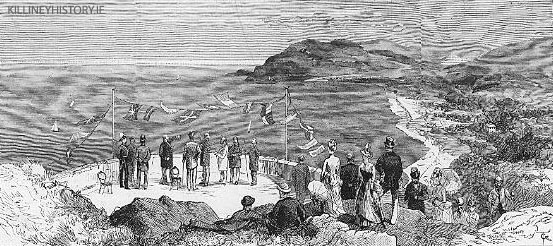Introduction
The recent opening of the upgraded entrance to Killiney Hill Park prompted us to delve into the history of the park and to record here the other milestones which form the early history of the hill and surrounding district, in particular the official opening of Victoria Park (as it was then known) in 1887. A striking feature of the history of the hill are the many, thankfully failed, attempts to build large speculative housing developments in and around the locality. All that survives of these today are the architect’s plans but the hill as we now know it came close to being lost as a public amenity on quite a few occasions. One of the earliest large scale proposals, Queenstown, was put forward by Robert Warren senior in 1840. Killiney Historical Society are delighted to host a talk by John Martin on these highly ambitious plans to develop the hill as a major residential enclave. The talk will take place on Tuesday 6th February at 8pm in the Druid’s Chair Pub. All are welcome, admission €5. See details here.
Earliest records setting out the ownership of Kiliney Hill (Scalpwilliam) from 1218
From before Norman times, Killiney was vested in the Priory of Holy Trinity, commonly called Christ Church, Dublin. The Talbots also were large landowners in the district from a period shortly after the Conquest. “In the year 1218 Reginald Talbot was found seized of Dalkey rendering there for a Goshawk annually: and in 1369 one of his successors, another Reginald Talbot, was sued in the Court of Exchequer for delivering therein as the rent of Dalkey one Goshawk, which on inspection and examination there, proving unsound and of no value, he was fined for his fraud.” In the 16th and 17th centuries the Talbot property extended all round Killiney, where it was merged for a while in that of the Mapas family, and extended as far as Loughlinstown.
Francis Elrington Ball. History of the County of Dublin (1902) pp 52-56
The lands (Rochestown including Scalpwilliam) appear to have been originally included under those of Dalkey, and were probably the lands of that place for which the Talbot family rendered annually to the Crown, in the thirteenth century, a goshawk, or its value, 6s. 8d.,—a substantial sum in those days. On account of their use for falconry, hawks were then much prized, especially Irish ones, and the goshawk was one of the largest birds used in the sport. Sometimes the value of the bird was paid, but the owner of Rochestown, in 1369, rendered his rent in kind, and had the effrontery to deliver a useless goshawk, for which he was fined by the Court of Exchequer. The tithes were paid to the Priory of the Holy Trinity, which was no less careful than the Crown to protect its rights, and employed an agent to see that the full amount of corn was delivered into its granary at Dean’s Grange. About the middle of the sixteenth century, the lands, which were occupied by a son of the owner of Loughlinstown, James Goodman, and on which a castle then stood, were held by the Talbots of Belgard, under another branch of the family, described as of Rathdown, and, possibly, were “the castle and lordship of Yenah called Dalkey,” which, in 1563, was assigned by Robert Talbot, of Belgard, to Matthew Birsell and Thomas Lawless.
At the beginning of the seventeenth century the lands of Rochestown, to which those of Scalpwilliam (Killiney Hill) were joined, and on which there were, besides the castle, a number of houses and a wood of considerable extent, had come into the possession of John Fagan, of Bullock, who held them under the Talbots. They were probably assigned by him to Alderman Robert Kennedy, who, before his death, in 1624, had purchased them in fee. Kennedy was a friend of John Fagan’s father, and owned much property in Dublin, including a celebrated mansion called Carberry House, in Skinner’s-row, in which he resided. He left a number of sons, and strictly entailed his real estate on his heirs male, but in the troublous times the family became extinct in the male line, and Rochestown was claimed, on the Restoration, by Patrick Mapas, the son of his youngest daughter.
Extract from ‘Some Residents of Monkstown’ read by F.E. Ball in 1898. This is a transcription of a return made in 1766 by the curate of Monkstown which Ball narrates with footnotes.
By Francis Elrington Ball from: The Journal of the Royal Society of Antiquaries of Ireland , Fifth Series, Vol. 9, No. 3 (Sep. 30, 1899), p. 240
We pass then through Dalkey, a decayed and deserted town, and come to Loftus Hill, the residence of Colonel the Hon. Henry Loftus, M.P., for Bannow, in the County Wexford. The name of this house has been several times changed ; built by the Malpas family, who own the soil, it was originally called Mount Malpas; then Captain Edward Maunsell, who occupied it for some years, called it Rocksborough; and now Mr. Loftus has changed its name to Loftus Hill. He has rebuilt the house, and, possessed of an unbounded passion and skill for improvement, has reclaimed the land, and planted the gardens with every kind of fruit tree, and with a most superb collection of flowers.
Footnote 4, p. 240. See Faulkner’s Dublin Journal, Sept. 23-26, 1752, for advertisement of Roxborough, formerly called Mount Malpas, containing about 150 acres of land, enclosed by a stone wall, and a new, well-finished house of six rooms and two large closets on a floor, with offices. Also see ” Topographical Description of Dalkey and the Environs “by Peter Wilson in Exshaw’s Magazine for 1770, p. 489, and lease from Malpas to Maunsell of July 12, 1763, and from Maunsell to Loftus of Feb. 28,1764, in Registry of Deeds Office. Loftus Hill appears to have been on the site of the present Killiney Castle. In 1790 Killiney Hill was in the possession of Lord Clonmell, the Chief Justice of the King’s Bench. It was said he was about to build a house there, and he had about 190 labourers employed in making roads. See Stealer’s Dublin Chronicle, Nov 11, 1790.
Rocque’s map of 1760
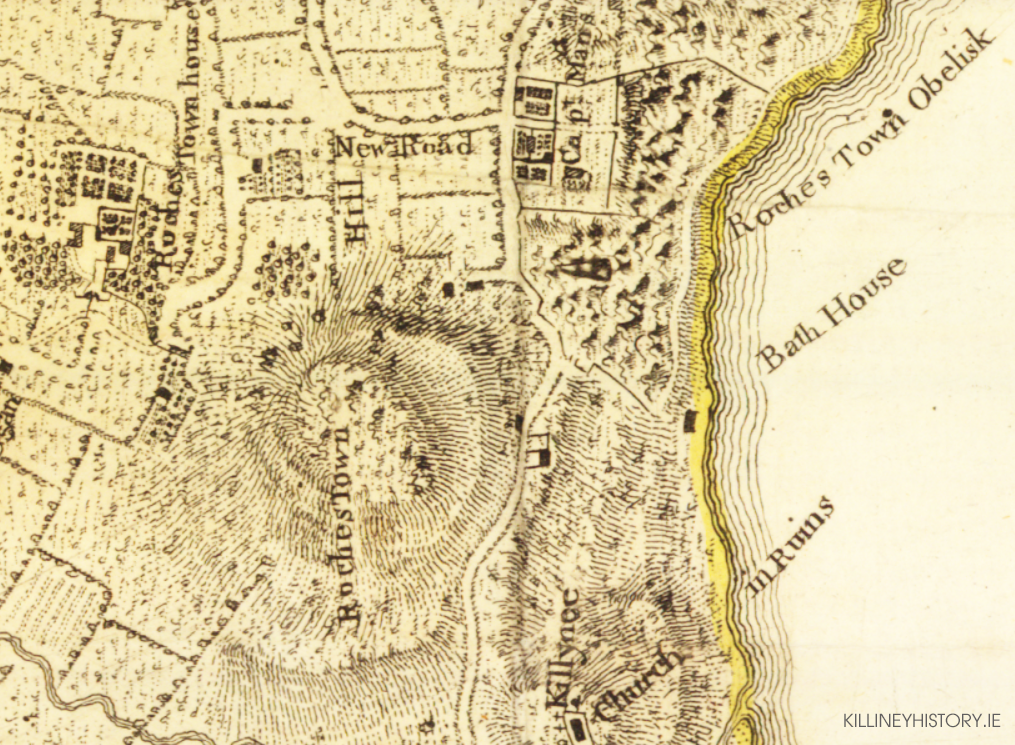
Ball continues on p.242 with more on the 1766 preambulation of Monkstown:
At the close of the sixteenth century, three brothers, sons of Walter Malpas of Dundalk, came to Dublin. One of them married a daughter of Alderman Robert Kennedy, who had purchased Rochestown from the Talbots, its original owners. Kennedy had five sons, but they died without issue, and under a decree of innocence, his great-grandson, by the marriage of his daughter to Francis Malpas, succeeded to the property. He married a daughter of the third Viscount Fitzwilliam of Merrion ; and it was his son who built the obelisk on Killiney Hill, and his great-grandson, Mr. John Malpas, who is in possession of the property at the time of our visit.(1766).
Footnote 3, p.242. A member of the family, Sir John Malpas, was the victor of Edward Bruce in the battle of Faughart, near Dundalk, in the fourteenth century. The Malpas succession, so far as relates to the ownership of Rochestown, is as follows:-Francis Malpas married Mary, daughter of Alderman Kennedy. His son, Patrick, married, and died in 1662-3. His eldest son, Christopher, married, in 1674, Rose, daughter of William, 3rd Viscount Fitzwilliam, and died in 1718. His eldest son, John, who built, in 1741, the obelisk on Killiney Hill, married Frances, daughter of Matthew, 7th Baron of Louth, and died in 1756. His eldest son, Christopher, married, and died in Germany in 1765. His eldest son, John, married, 1st, in 1757, Catherine, daughter of Sir Andrew Aylmer, Bart., and 2ndly, in 1762, Martha, daughter of Thomas Wheatley of Ashton, Cheshire, and died in 1793. His only surviving child (by the second marriage) and heiress, Catherine, married, in 1789, Richard Wogan Talbot, afterwards created Lord Talbot de Malahide, and the Rochestown estate thus passed again to the Talbots.
Killiney Hill by Francis Elrington Ball. History of the County of Dublin (1902) pp 56-59
In this updated article Ball further enlightens us:
Killiney Hill stands in the townland of Mount Mapas, or Scalpwilliam. The lands of Scalpwilliam are first mentioned under that name in the beginning of the seventeenth century, and from that time followed the same devolutions of ownership as the Rochestown property. The obelisk, which stands on the summit of the hill, and which is a very prominent object, was erected by Mr. John Mapas, in 1741, a year of scarcity and hardship, when fever and famine devastated Ireland. It bears the quaint inscription: “Last year being hard with the poor, the wall around these hills and this were erected by John Mapas, Esq. June, 1742.”
About the same time a house had been built on or near the site of Killiney Castle. It contained considerable accommodation, and its sea and land prospect was accounted the finest in Ireland. Except towards the sea, “where nature had sufficiently enclosed them,” the lands were surrounded by a stone wall, and were estimated to contain some 150 acres. The house had been originally called Mount Mapas, but, in 1755, was known as Roxborough. It was then in occupation of Captain Edward Maunsell, who served as High Sheriff of the County Dublin in that year. He had married a daughter of Philip Ridgate, LL.D., the widow of Mr. William Roberts, and on his death, which took place in 1765, in York-street, Dublin, left by her an only son. This son, Thomas Ridgate Maunsell, afterwards resided with his mother in Rochestown Avenue, and devoted much time to genealogical research, with the object of compiling a history of his family. Lead had been discovered on the lands of Roxborough, and mines had been, in 1751, opened, which, two years later, when a vein of great thickness was discovered, were reported to be in a most flourishing condition. They were closed a few years later, and a second attempt to work them in 1784 proved equally unsuccessful.
Before his death Captain Maunsell assigned his interest in Roxborough to Colonel the Hon. Henry Loftus, M.P. for Bannow, in the County Wexford.
Sherrard’s map of the Malpas Estate, 1787
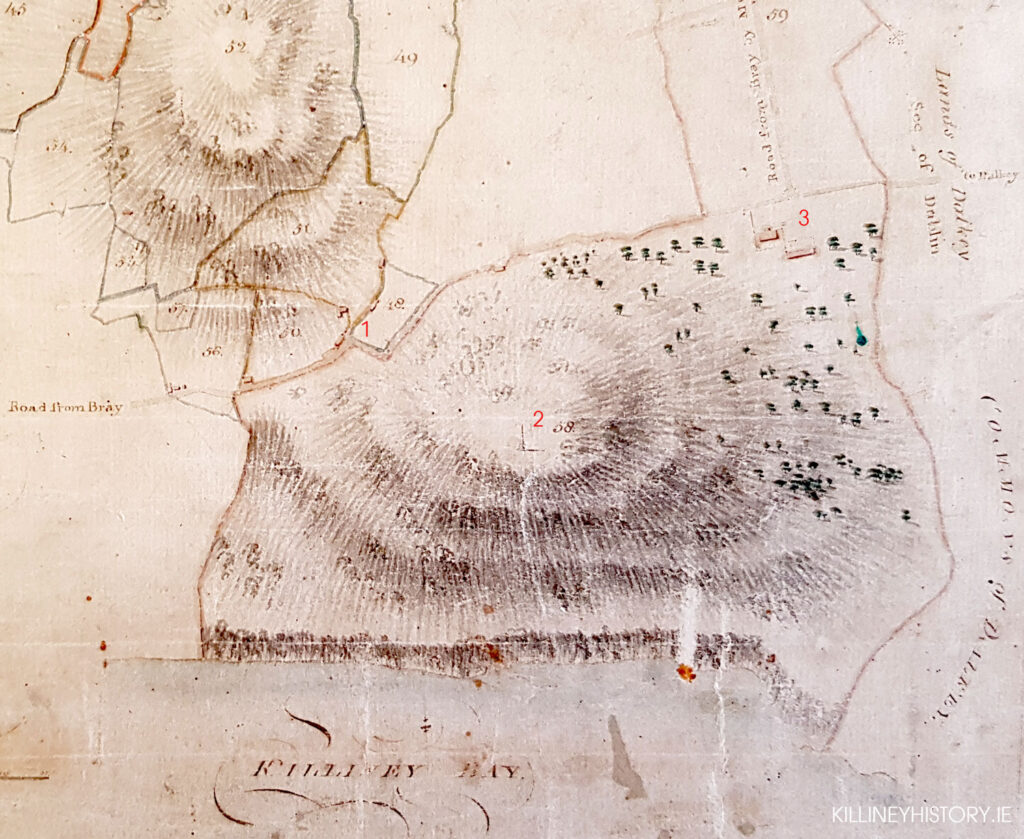
Possessed with an unbounded passion for improvement, and a skill equal to that passion, as a contemporary writer says, Loftus converted the barren hills and rocks round Roxborough, called by him Loftus Hill, into good meadow and pasture lands, frequently being obliged to blast the rock, and to draw earth to cover it, in order to obtain his object. Round the hill he cut the present road, and planted the west side with trees and shrubs. The house was a large one, but the offices were small. It was his intention to rebuild them, but this he did not accomplish, as in Rathfarnham Castle, the ancient seat of the family, which he repurchased for his nephew, and succeeded to himself, he found greater scope for the extravagant magnificence which is displayed in the classic gateway on the Dodder, constructed by him. After his succession to the titles Lord Loftus disposed of Loftus Hill; in 1778 it was occupied by Mr. Medlicott, and subsequently by Mr. Minchin.
The hill was, in 1790, taken by Lord Clonmell, with the intention of erecting a mansion there in place of his seat at Temple Hill, but his improvements ended in the construction of a park, at a cost of some £3,000 which, on its completion, he stocked with deer. Nearly 200 men were employed by him at one time in that work, and in making roads and planting. A tourist in 1796 describes a handsome banqueting hall, which was built by Colonel Loftus, and mentions that, in addition to the obelisk, which Lord Clonmell had restored, a memorial was about to be placed on the hill, in pursuance of the will of the last Mr. Mapas, who left a large sum for the erection of a monument to his family. During the last century the neighbourhood was much developed by Mr. Robert Warren, of Killiney Castle, whose name, as its restorer in 1840, the obelisk bears, and the hill having been purchased for a park, was, in 1887, opened and dedicated to the public use by the late Prince Albert Victor of Wales, in memory of Queen Victoria’s Jubilee.
The Three Sisters
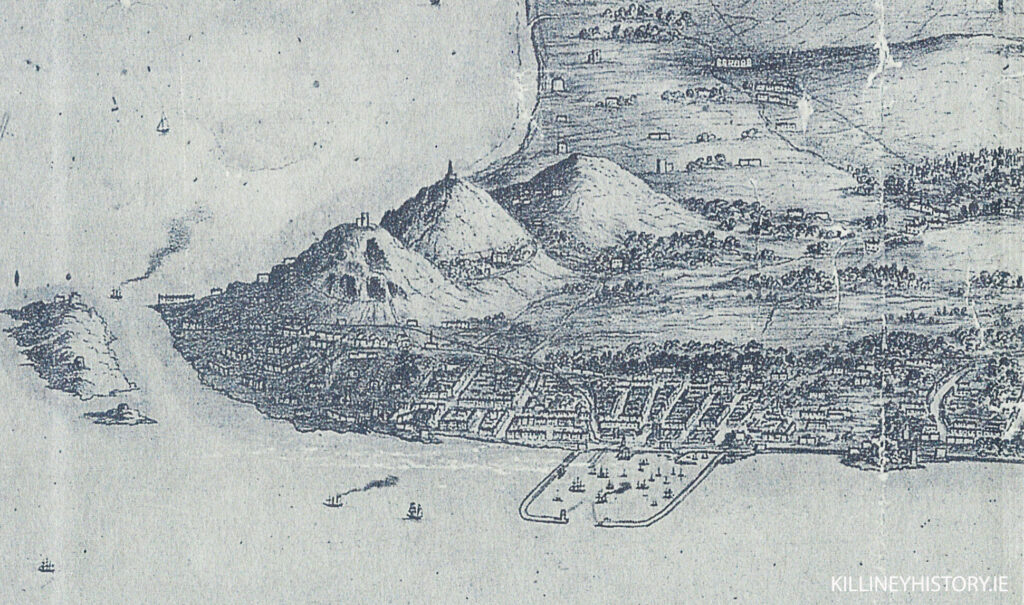
Killiney Hill is flanked by it’s two sister hills, Rochestown Hill and Dalkey Hill. Known collectively as the three sisters they command the coastal skyline of south county Dublin and their landmark status remains to this day. Dalkey Hill, sometimes called Telegraph Hill, served as the main source of granite for the building of Dun Laoghaire Harbour. The scars left behind by this quarrying activity are now the main feature of the hill which is popular with rock climbers and general visitors alike. It’s prominent location also made it the ideal spot for the telegraph tower which was used to send semaphore messages between the Martello towers along the coast. The ruins of the tower still dominates the hill today. Killiney Hill was the highest of the three and became the destination for day trippers from the city to view Killiney and Dublin Bays from the one vantage point. The added attraction of Killiney Strand meant that the spot became extremely popular given it’s proximity to the city along with the ever improving transport infrastructure. Much of the commercial activity in Killiney Village grew out of the necessity to cater for the visitors. The following explosion in the local population and the housing development were ushered in by the arrival of the Railway in 1854. The third of the three hills, Rochestown Hill (3 on the map below), was also used for quarrying when lead was discovered here giving rise to the naming of Glenalua Road, Gleann a Luadh or the Valley of Lead.
Taylor’s map of 1816

The three sisters as shown on Taylor’s map of 1816. Killiney Hill Park (2) is indicated as a Deerpark and the entire, including what is now the Killiney Castle Hotel, is called Loftus Hill.
Obelisk Hill Railway Station
1854 marked the arrival of the railway in Killiney. Killiney Hill, then known as Obelisk Hill, gave it’s name to the first station to open, Obelisk Hill Station.
Robert Warren senior, who owned the Killiney Hill estate from 1834 to 1869, facilitated the Dublin & Wicklow Railway (D&WR) by allowing the line between Bray and Dalkey, which that company built in 1853- 54, to traverse his property at the Vico Fields. In addition to compensation paid to him by the Railway Company, he was also provided with a halt, known as Obelisk Hill, and a footbridge that gave access to White Rock beach. Although Obelisk Hill was initially a private halt when the line opened on 10th July 1854, the D&WR agreed in June 1855 to open it up for public use on a temporary basis. However, it did not last long due to it’s very inaccessible location and it was decided to build a new station at Killiney, 5/8 mile further south, once a roadway had been provided. In September 1857 Robert Warren wrote to the D&WR stating that the road would be ready on 1st October, and requesting that the new station should be commenced. Obelisk Hill station was closed on and from 1st January 1858; the new Killiney station being opened on the same day.
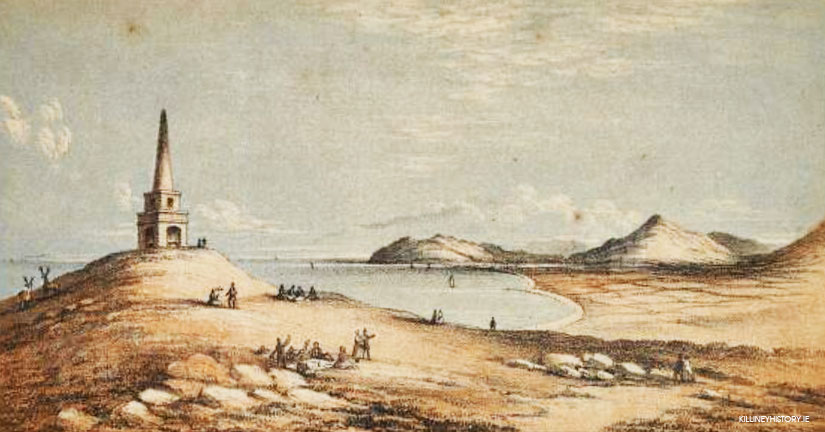
Newspaper report which appeared in The Freemans Journal on 1st July 1887 describing the official opening of Victoria Hill on 30th June 1887 by Prince Albert Victor of Wales.
OPENING KILLINEY HILL
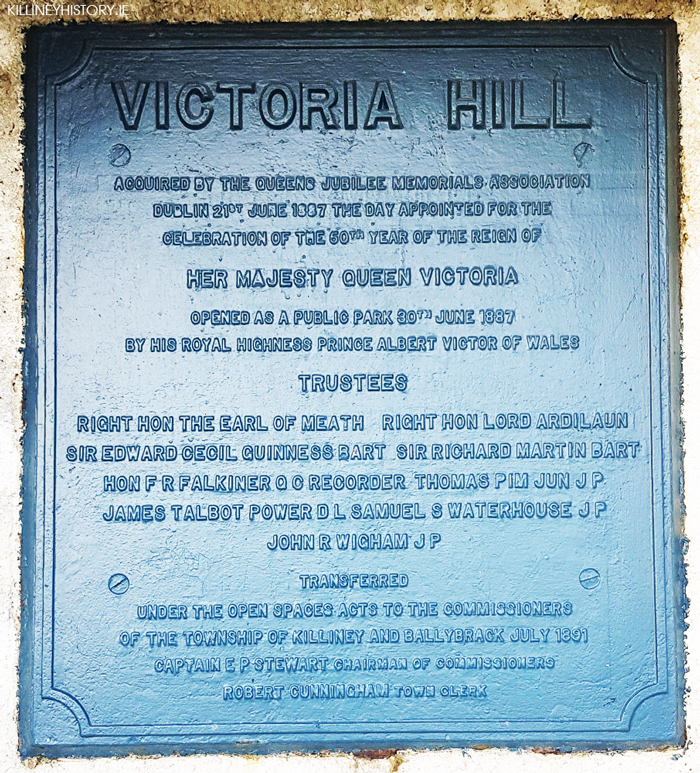
From an early hour in the afternoon fashionable crowds came by rail and road to Killiney, and made their way to the Obelisk Hill. At any time Mr. Warren’s property at Killiney would be admitted to be a charming spot, and it never looked to better advantage than last evening. It was gaily decorated from the entrance gate to the point of the Obelisk with bunting of every shade, while not a cloud was visible to mar the truly magnificent view of Dublin Bay and the picturesque coast landscapes. The prospect formed a very noble picture indeed – the suburban townships lying to the right and left, with the Hill of Howth and Bray Head forming the land boundary to seaward, near the verge of the horizon. A background which would have charmed the soul of an artist was formed by the Wicklow and Dublin Mountains. The new park at Killiney has been purchased by the Amalgamated Jubilee Committee from Mr. Robert Warren, DL, for the people of the city and county of Dublin, to whom it will prove a great boon if properly attended to – if it is made more accessible to the public. It is to be hoped that when the jubilee year and its honours have passed away that this beautiful spot will be preserved for the people and not allowed to become more common, as many have been pessimistic enough to predict that it will. The following noblemen and gentlemen comprise the committee who successfully carried out the preliminary and final negotiation for the purchase of the place, which will henceforth be known as Victoria Hill.
The Right Hon Lord Viscount Monck, DL, Lord Lieutenant of the county and of the city of Dublin, chairman; Henry Alexander Hamilton, High Sheriff county Dublin, vice-chairman; David Drummond, JP; Sir Percy Grace, Bart, DL: Edward H Kinahan, JP; Thomas Pim, jun, JP; James Talbot Power, DL; Thos Synnott, JP, hon treasurers; Ion Trant Hamilton, DL; John Malcolm Inglis, JP; Rev John H Jellett, DD, Provest TCD; Sir Richard Martin, Bart, DL; Frederic W Pim, Thomas Talbot Power, David Sherlock, B L; Sir Edward Sullivan, Baronet, hon secretaries; and the Right Hon Lord Ardilaun, Lord James W Butler, Maurice Brooks, DL; Samuel Boyd, JP; John Lloyd Blood, JP; Gibson Black, JP; Sir Charles Cameron, MD; Robert Keating Clay, Alderman Cochrane, DL; James Dillon, CE; James Dobson, JP; the Hon the Recorder of Dublin, the Right Hon Judge Flanagan, William Findlater, DL; John Fleming, J P; Thos W Grimshaw, MD. Registrar- General; Samuel Gordon, MD; Sir E C Guinness, Bart, DL; Robert Herron, JP; Brindley Hone, T Maxwell Hutton, DL; the Right Hon Sir Patrick J Keenan, PC, KCMG, CB; the Right Hon the Earl of Meath, Capt the Hon H Monck, DL; Marcus T Moses, Phillip F McMahon, JP; John McEvoy, JP, Samuel McComas, JP; Alderman George Moyers, LL D, JP; Sir George Owens, MD, JP; the Right Hon Lord Viscount Powerscourt, Robert Sexton, JP; Samuel S Waterhouse, JP: William Watson, JP; Henry Wigham, JP; John R Wigham, JP.
Their Royal Highnesses Prince Albert Victor and Prince George of Wales, accompanied by his Excellency the Lord Lieutenant and his Grace the Duke of Abercorn, arrived at about five o’clock, and were received by the following members of the committee, who acted as stewards, vis: The Recorder of Dublin, Sir Richard Martin, L Hutton, RK Clay, SS Waterhouse, JP; J. Spencer, Marcus Moses, JP; Maurice Brooks, DL; T Shingley, S McComas, Captain Johnston, JR Wigham, JP; Henry Wigham, JP; J M Inglis, J Synnott, J Fleming, JP, S Boyd, JP; William Findlater, J P; Alderman Cochrane, J P; the Hon Captain Henry Monck, High Sheriff County Wicklow; &c.
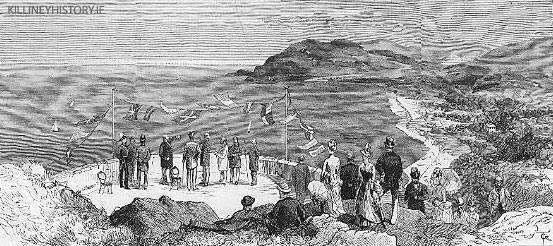
The party then proceeded to the portion of the grassy walk leading to the summit of the hill, which forms a sort of natural balcony from which an excellent view of the county in the direction of Bray can be obtained. On leaving here they received a military salute from a guard of honour consisting of 100 men of the Welsh Regiment, the band of which, together with that of the Royal Irish Constabulary, played “God Save the Queen.” At the southern face of the obelisk a handsome platform and canopy was created, to which the Royal visitors were conducted by the stewards, Mr. RK Clay leading.
The Recorder briefly explained that the place on which they stood had been purchased by the Queen’s Jubilee Memorial Committee to be given to the people as a lasting memento of the present reign, and called upon the hon secretary to read the address.
Mr. J R Wigham then read the following address- TO HIS ROYAL HIGHNESS PRINCE ALBERT VICTOR CHRISTIAN EDWARD OF WALES, KG, KP. MAY IT PLEASE YOUR ROYAL HIGHNESS-The Queen’s Jubliee Memorials Association of the county and city of Dublin tender to your loyal Highness their dutiful salutations and their most hearty welcome upon the occasion of your visit to Ireland. In greeting your Royal Highness as representing her Most Gracious Majesty the Queen in our Irish celebrations of her jubilee year the Association would express to your Royal Highness their grateful sense of the gracious spirit in which their wish has been received that your Royal Highness should personally inaugurate the opening and the dedication to the people of “Victoria Hill, Killiney,” in commemoration of the great event of this auspicious year. This Memorial Association was formed in the present month by the union of the two committees appointed in the county of Dublin and in the city of DubIin respectively, for the purpose of perpetuating the memory of the happy epoch, and of giving permanent form to the feelings which pervade this ancient city and county of loyalty to the Throne, of respectful love to the person of her Majesty and of high admiration for the Royal and womanly virtues which have marked the fifty years of her illustrious rule. It may not be unpleasing to her Majesty and to your Royal Highness to know that in each of the pageants for the celebration of the Jubilee, the several committees, in sympathy, as they well know, with her Majesty’s sentiments, have sought the welfare of the people either by alleviating distress or promoting the health and happiness of the industrial classes. It is in this spirit that the present memorial has amongst others been selected by the association with the object of securing for ever this famous hill, with its beautiful scenery and sajubrious site, which, hitherto of private ownership, may be henceforth enjoyed by the people with enhanced attractions and increased facility of access We cordially welcome his Royal Highness Prince George who is with you on this occasion, and we hope that you may both soon revisit this country. We thank your Royal Highnesses for your kind help today, and we feel sure that you join in our fervent prayer that the Most High may bless this work in which you are assisting us. That His blessing may accompany all your labours everywhere is our earnest desire.-Signed on behalf of the Queen’s Jubilee Memorials Association, Dublin, FREDERICK FALKINER, Recorder of Dublin, Chairman of Reception Committee. ION TRANT HAMILTON, DL, J MALCOLM INGLIS, J P, RICHARD MARTIN, Bart, DL, FREDERIC W PIM, THOMAS TALBOT POWER, DAVID SHERLOCK, BL, EDWARD SULLIVAN, Bart, JOHN R. WIGHAM, JP.
The address, which was beautifully designed, was executed by pupils of the Irish Association for the Employment of Women, 21 Kildare street, under the supervision of their talented instructor, Mr. James McConnell.

Mr. Wigham handed the address to the Recorder, who presented it to Prince Albert. His Royal Highness Prince Albert Victor in reply said – Mr. Recorder and gentlemen, I thank you most sincerely for the very warm and hearty welcome which you have accorded me this day. It is a great pleasure, I can assure you, to be enabled to mark this occasion by opening and dedicating to the people of Dublin the Victoria Hill, Killiney, and I trust that it will ever serve to recall to their minds joyful recollection of this jubilee year (cheers). I shall not fail to make her Majesty acquainted with the loyal expressions of devotion to her throne and person which have emanated so spontaneously from the various committees representing the people in the city and county of Dublin who had been appointed to perpetuate the happy epoch. I most heartily congratulate them on the thought which prompted them to select this most beautiful spot as a lasting memorial and benefit for the community (cheers). My brother joins with me in thanking you again for the most cordial manner in which you have received us today. It now only remains for me to declare this hill open and to name it Victoria Hill, Killiney (cheers). Two rockets were then sent up and the Royal Standard lowered and hoist again as a signal that the proceedings had concluded. Their Royal Highnesses were then conducted round to the Dublin side of the obelisk, from which they observed a salute being fired in answer to the signal from H M S Belleisle which lay in Kingstown harbour, almost beneath their feet. The proceedings then terminated, and the party returned to their carriages and drove to Kingstown for the purpose of embarking for England.
The Old Green Road. From Glimpses of Old Dalkey by F. M. O’Flanagan
Extract from Dublin Historical Record, Dec., 1941 – Feb., 1942, Vol. 4, No. 2. p.50
Going through a little wooden gate in the cul-de-sac at “Ard Muire” (the “Mount Henry” of Shaw’s letter) we enter on a beautiful quiet road, high above the Vico Road and untrodden except by a few who know the quiet and beauty to be found and seen from there. This is known as the “Old Green Road “-it is still carpeted with velvety short grass-and is reputed to have been laid out for the same George of England after whom Kingstown was named, to drive and admire the view. Mrs. Chippendall Higgin of Killiney Castle brought out from the Dublin Exhibition of 1907 a model bungalow and had it erected there, and often used it to dispense hospitality to her guests in these ideal surroundings. Rare plants and trees which she had planted may still be seen near the site. In the Black-and-Tan War it was used as a H.Q. by the local I.R.A. and again by the Republicans in the Civil War, when it met its end in flames at the hands of the Free State troops. Those who examined it at the Exhibition could have had little idea of the strange future in store for its timbers!
Further on this “Old Green Road” may be seen silhouetted above against the skyline, it can also be seen from the Vico Road, a striking granite figure of a bird about 4 feet high. This is known as the “Eagle of Vico” and is commonly put down as the work of Nature. Knowing that granite is too hard to weather, even after centuries, into such a shape-rather would it break off in lumps I was sceptical and looked for another explanation. This I eventually obtained from Mr. Joe Archbold, aged over 80 years, retired world seafarer and pilot. He says that the “Eagle was fashioned out of a piece of granite by two brothers, Joe and Tom Cooper, stonemasons, who lived in a lodge at the back of “St. Germains, near “Mount Henry.” So after the lapse of over 70 years let us give them, and not Nature, the credit for this outstanding landmark.
